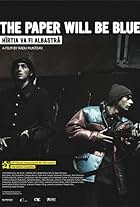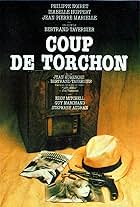Comment j'ai fêté la fin du monde
Titre original : Cum mi-am petrecut sfârsitul lumii
- 2006
- Tous publics
- 1h 46min
NOTE IMDb
7,1/10
3,3 k
MA NOTE
Ajouter une intrigue dans votre langueIn Communist-era Romania, people live with hope for a new life of freedom.In Communist-era Romania, people live with hope for a new life of freedom.In Communist-era Romania, people live with hope for a new life of freedom.
- Réalisation
- Scénario
- Casting principal
- Récompenses
- 7 victoires et 7 nominations au total
Avis à la une
I have just seen this movie and I loved it. Maybe for the little boy who plays his role very well, maybe for the strange relationship that Eva has with either guys, but especially for how the director managed to capture the communist era in every aspect of the movie. Romanians may understand this better. The revolution took place almost 17 years ago, a new regime was installed since then and almost everything has changed. But this movie brings back even the smallest detail, from the clothes that students wore, music they listened to, even haircuts they had, to the state of the streets, houses, cars. It's amazing, but I had the strong impression that the movie was made many years ago. I would recommend this movie to all Romanians because, in a small detail, it gives a different perspective about the revolution. But also, non-Romanians should watch it just to see how difficult times we have been through.
I've been trying to watch all Romanian films of late, although without much success. Some are just too ludicrous and others simply can't arouse any interest on my behalf.
I'd seen Trafic from Mitulescu, a slice of life piece from the busy happenings of Bucharest, which was a celebrated achievement of Romanian cinema at that time - with some merit. Now, "Cum mi-am petrecut sfarsitul lumii" is, firstly, a film with a striking title that can lead you on - erroneously. Going beyond the metaphor, I guess you can accept it as what the end of communism symbolized: the end of an era.
The film itself is about a young girl, Eva, (very well played by D. Petre) who is not only passing through the usual problems which come with adolescence, but who must also bear the weight of communism and its effects on her shoulders. I myself saw in her a prototype of the modern woman, the one who wants to think for herself and act as she deems is correct (but who also understands the importance of sacrificing herself at times), and all this burden of age and political restraints are fantastically mirrored on D. Petre's face. However, the film doesn't really go far beyond illustrating the last segment of the Ceausescu era - the fear, the hate, the desire to flee. While Eva's constant struggle, between responsibility (family) and rebellion, does deliver a certain dose of tension and dynamics, the film felt unsatisfying in the end.
What I'm referring to is that feeling you expect to encounter after a rather warm film about a different kind of childhood with a rather different sort of dreams: that overwhelming experience of fulfillment - both what the characters are concerned and the audience. So while "Cum mi-am petrecut sfarsitul lumii" has its good moments and conveys a very true perspective of those days, it simply did not satisfy me. Maybe it's the fact that I "missed out" on the era and, consequently, can't truly understand them. But what I felt was real enough for me, so the problem must lie within the story.
I'd seen Trafic from Mitulescu, a slice of life piece from the busy happenings of Bucharest, which was a celebrated achievement of Romanian cinema at that time - with some merit. Now, "Cum mi-am petrecut sfarsitul lumii" is, firstly, a film with a striking title that can lead you on - erroneously. Going beyond the metaphor, I guess you can accept it as what the end of communism symbolized: the end of an era.
The film itself is about a young girl, Eva, (very well played by D. Petre) who is not only passing through the usual problems which come with adolescence, but who must also bear the weight of communism and its effects on her shoulders. I myself saw in her a prototype of the modern woman, the one who wants to think for herself and act as she deems is correct (but who also understands the importance of sacrificing herself at times), and all this burden of age and political restraints are fantastically mirrored on D. Petre's face. However, the film doesn't really go far beyond illustrating the last segment of the Ceausescu era - the fear, the hate, the desire to flee. While Eva's constant struggle, between responsibility (family) and rebellion, does deliver a certain dose of tension and dynamics, the film felt unsatisfying in the end.
What I'm referring to is that feeling you expect to encounter after a rather warm film about a different kind of childhood with a rather different sort of dreams: that overwhelming experience of fulfillment - both what the characters are concerned and the audience. So while "Cum mi-am petrecut sfarsitul lumii" has its good moments and conveys a very true perspective of those days, it simply did not satisfy me. Maybe it's the fact that I "missed out" on the era and, consequently, can't truly understand them. But what I felt was real enough for me, so the problem must lie within the story.
A trip in memory. A story about an age and about an era. Only character of this movie is Ceausescu. And his presence in ours souls. At a first view is a combination Chagall-Blecher. A page of a old book. A yellow image. But the Romania of 1989 is the Romania of 2006, too. Same words, same dreams, same facts are the pieces of our life. To escape, to have, to be are the problems of everyday. So... . The extraordinary talent of Catalin Mitulescu is the result of a long clear deep observation of the pictures of present Romania. In this film is not the testimony of a communism's drop, a tale about love, absurd, lies and honor. It is a chronicle, a gorgeous chronicle about Revolution, Piata Universitatii, Iliescu regime, about Miron Cosma and the empty hope, about condition of Romanians, ever strange, ever cold. Lalalilu is our conscience. Ours jokes, patience, wait are the fruits of his desire to understand. "Our country is our country". It is possible a better definition of our condition?
Not too strong on plot, "How I spent the end of the world" is strong on mood and feeling, and it very well compensates. I usually don't go crazy about "mood pieces" but this is definitely more. I caught the film at the up and coming Transylvania Film Festival (Tiff for short) where the film had its national premiere after a decent reception at Cannes only a few weeks earlier. The film is a MUST for any Romanian who has lived through the Ceausescu years as the filmmakers went through great pains to accurately depict the mood of those days from general landscape to the toy trucks, school uniforms and furniture all Romanians possessed and shared during an era of uniform mass-production. The film stands out as the harbinger of something historians will hopefully refer to as "the Romanian New Wave." With films like this, and "Marilena from P7" as well as Porumboiu's "Has it Been, Has it not Been" (another personal take on the shattering Revolution of 1989), Romanian cinema is finally entering the world circuit, and will hopefully stay there for a while.
Beautiful indeed. The beauty of this film is that it presents with high fidelity a era not so long ago in our life but so long ago in our memories. It's like you were closing your eyes and go back in those time. The atmosphere is recreated in the smallest details. Even the bottles of milk are the same they were 20 years ago. The director is not a judge, he just presents facts through eyes of different persons, as he recreates the every day life of people. this film is not a film of hate as we were used 17 years when we saw film about that times. It is a film to see with your heart open, with your soul free of any ideeas. It is a film of making peace with the past and with ourself. Take just little from your time and go see it.
Le saviez-vous
- AnecdotesRomania's official submission to the 79th Academy Awards (2007) for Best Foreign Language Film.
- GaffesThere is a longer scene in the movie showing a bus trying to turn around on muddy soil. The bus is a Rocar bus, which has been produced only after 1990, and it has stickers on its doors, which surely have not been used before 1989.
- Bandes originalesMarsul de Intampinace
Written by anonymous
Copyright 2006 by Strada Films & Les Films Pelléas
Meilleurs choix
Connectez-vous pour évaluer et suivre la liste de favoris afin de recevoir des recommandations personnalisées
- How long is How I Celebrated the End of the World?Alimenté par Alexa
Détails
- Date de sortie
- Pays d’origine
- Site officiel
- Langue
- Aussi connu sous le nom de
- How I Celebrated the End of the World
- Lieux de tournage
- Sociétés de production
- Voir plus de crédits d'entreprise sur IMDbPro
Box-office
- Budget
- 1 500 000 € (estimé)
- Montant brut mondial
- 296 980 $US
- Durée
- 1h 46min(106 min)
- Couleur
Contribuer à cette page
Suggérer une modification ou ajouter du contenu manquant






















